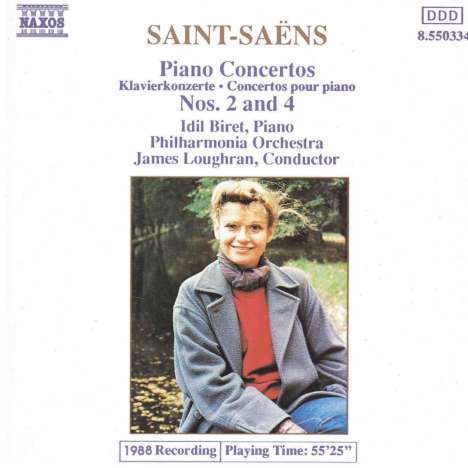Camille Saint-Saens: Klavierkonzerte Nr.2 & 4 auf CD
Klavierkonzerte Nr.2 & 4
Herkömmliche CD, die mit allen CD-Playern und Computerlaufwerken, aber auch mit den meisten SACD- oder Multiplayern abspielbar ist.
Lassen Sie sich über unseren eCourier benachrichtigen, falls das Produkt bestellt werden kann.
- Künstler:
- Idil Biret, Philharmonia Orchestra, James Loughran
- Label:
- Naxos
- Aufnahmejahr ca.:
- 1988
- UPC/EAN:
- 4891030503342
- Erscheinungstermin:
- 21.3.1991
Ähnliche Artikel
Saint-Saëns zeigte als Junge rasche Intelligenz, breite Interessen und eine beträchtliche musikalische Frühreife. Er trat 1848, ein Jahr nach dem Tod Mendelssohns, in das Pariser Konservatorium ein und wurde unter anderem von Berlioz, der von seiner Begabung als Komponist und Pianist beeindruckt war, sehr ermutigt. Das zweite seiner fünf Klavierkonzerte, das g-Moll-Konzert Opus 22, entstand 1868 innerhalb von siebzehn Tagen auf Wunsch von Anton Rubinstein mit Saint-Saëns als Solist. Dasselbe Konzert brachte eine größere zeitgenössische Anziehungskraft in Sarasates Aufführung des ersten Violinkonzerts des Komponisten, das vom Publikum herzlicher aufgenommen wurde. Liszt gab jedoch seine gütige Zustimmung und Ermutigung: Saint-Saëns beeindruckte ihn und war auf jeden Fall einer der wenigen französischen Pianisten, die Liszts eigene Klaviertranskriptionen aufführten.
Das Konzert beginnt mit einer Kadenz über einen langen, getragenen Ton, gefolgt von einem ersten expressiven Thema, dem wiederum ein zweites Thema folgt, das wiederum zuerst dem Solisten anvertraut wird. Der zweite Satz wird von den Pauken eingeleitet und stützt sich auf zwei kontrastierende Themen von deutlich unterschiedlichem Charakter, das erste ganz im Geiste eines Scherzos und das zweite von offenkundig populärem Charakter. Im letzten Satz zeigt Saint-Saëns seine Beherrschung einer brillanten Klavierkunst und beendet das Konzert mit beträchtlichem Elan.
Wie auch immer die unmittelbare Reaktion des Publikums im Cirque d'hiver ausfallen mag - und die Kritiker hatten zumindest die Themen des Scherzos als eingängig genug empfunden -, Saint-Saëns wandte sich sofort der Komposition eines dritten Klavierkonzerts zu, das in Leipzig zum ersten Mal vor einem wenig begeisterten Publikum aufgeführt werden sollte. Das vierte Konzert wurde 1875 geschrieben. Es veranlasste Gounod zu einem schmeichelhaften Vergleich seines Komponisten mit Beethoven. Das Werk ist in seiner Form weniger konventionell als sein Vorgänger und besteht aus zwei Sätzen. Der erste Satz bietet ein Thema, das von Solist und Orchester geteilt wird, und entwickelt, bevor ein zweiter Abschnitt erscheint, ein Andante in As-Dur. Der zweite Satz beginnt mit einem Scherzo, das thematisch mit dem ersten Satz verbunden ist, der später offen in Erscheinung tritt, ebenso wie eine lyrische Episode aus dem zweiten Abschnitt des ersten Satzes. Eine Kadenz führt ohne Unterbrechung in eine transformierte Version des Andante-Themas des ersten Satzes in einem Finale, das weitere Verweise auf frühere Ideen enthält und dem ganzen Werk eine thematische Einheit verleiht, die in den anderen Klavierkonzerten von Saint-Saëns nicht zu finden ist.
Product Information
Saint-Saëns as a boy showed quick intelligence, wide interests and considerable musical precocity. He entered the Paris Conservatoire in 1848, a year after the death of Mendelssohn, and met with considerable encouragement from Berlioz, among others who were impressed by his gifts as a composer and as a pianist. The second of his five piano concertos, the Concerto in G Minor, Opus 22, was written in the space of seventeen days in 1868 at the request of Anton Rubinstein, with Saint-Saëns as soloist. The same concert brought a greater contemporary attraction in Sarasate's performance of the composer's first violin concerto, welcomed more warmly by the audience. Liszt, however, gave his gracious approval and encouragement: Saint-Saëns impressed him, and was, in any case, one of the few French pianists to perform Liszt's own piano transcriptions.
The concerto opens with a cadenza over a long, sustained note, followed by a first expressive theme, succeeded in turn by a second subject, again entrusted first to the soloist. The second movement is introduced by the timpani and relies on two contrasting themes of markedly different character, the first very much in the spirit of a scherzo, and the second of overtly popular character. In the last movement Saint-Saëns displays his command of brilliant piano-writing, ending the concerto with considerable panache.
Whatever the immediate reaction of the Cirque d'hiver audience -and critics had at least found the themes of the scherzo catchy enough - Saint-Saëns immediately turned his attention to the composition of a third piano concerto, to be performed for the first time in Leipzig before an unenthusiastic audience. The fourth concerto was written in 1875. It prompted Gounod's flattering comparison of its composer to Beethoven. Less conventional than its predecessor in form, the work is in two movements. The first of these offers a theme shared by soloist and orchestra and duly developed, before the appearance of a second section, an Andante in A flat. The second movement starts with a scherzo, thematically connected with the first movement, which later makes an open appearance, as does a lyrical episode from the second section of the first movement. A cadenza leads without a break into a transformed version of the first movement Andante theme in a finale that includes further reference to earlier ideas, giving the whole work a thematic unity not found in the other piano concertos of Saint-Saëns.
Disk 1 von 1 (CD)
Konzert für Klavier und Orchestra Nr. 2 g-moll op. 22
-
1 1. Andante sostenuto
-
2 2. Allegro scherzando
-
3 3. Presto
Konzert für Klavier und Orchester Nr. 4 c-moll op. 44
-
4 1. Allegro moderato
-
5 2. Allegro vivace
-
6 3. Andante
-
7 4. Allegro











